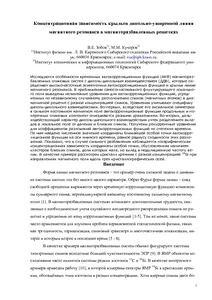Concentration Dependence of the Wings of a Dipole-Broadened Magnetic Resonance Line in Magnetically Diluted Lattices
Скачать файл:
URI (для ссылок/цитирований):
https://link.springer.com/article/10.1134/S106377611615005Xhttps://elib.sfu-kras.ru/handle/2311/70257
Автор:
Zobov, V. E.
Kucherov, M. M.
Коллективный автор:
Институт космических и информационных технологий
Кафедра прикладной математики и компьютерной безопасности
Дата:
2017-01Журнал:
Journal of Experimental and Theoretical PhysicsКвартиль журнала в Scopus:
Q2Квартиль журнала в Web of Science:
Q3Библиографическое описание:
Zobov, V. E. Concentration Dependence of the Wings of a Dipole-Broadened Magnetic Resonance Line in Magnetically Diluted Lattices [Текст] / V. E. Zobov, M. M. Kucherov // Journal of Experimental and Theoretical Physics. — 2017. — Т. 124 (№ 1). — С. 151-158Аннотация:
The singularities of the time autocorrelation functions (ACFs) of magnetically diluted spin systems with dipole–dipole interaction (DDI), which determine the high-frequency asymptotics of autocorrelation functions and the wings of a magnetic resonance line, are studied. Using the self-consistent fluctuating local field approximation, nonlinear equations are derived for autocorrelation functions averaged over the independent random arrangement of spins (magnetic atoms) in a diamagnetic lattice with different spin concentrations. The equations take into account the specificity of the dipole–dipole interaction. First, due to its axial symmetry in a strong static magnetic field, the autocorrelation functions of longitudinal and transverse spin components are described by different equations. Second, the long-range type of the dipole–dipole interaction is taken into account by separating contributions into the local field from distant and near spins. The recurrent equations are obtained for the expansion coefficients of autocorrelation functions in power series in time. From them, the numerical value of the coordinate of the nearest singularity of the autocorrelation function is found on the imaginary time axis, which is equal to the radius of convergence of these expansions. It is shown that in the strong dilution case, the logarithmic concentration dependence of the coordinate of the singularity is observed, which is caused by the presence of a cluster of near spins whose fraction is small but contribution to the modulation frequency is large. As an example a silicon crystal with different 29Si concentrations in magnetic fields directed along three crystallographic axes is considered.

